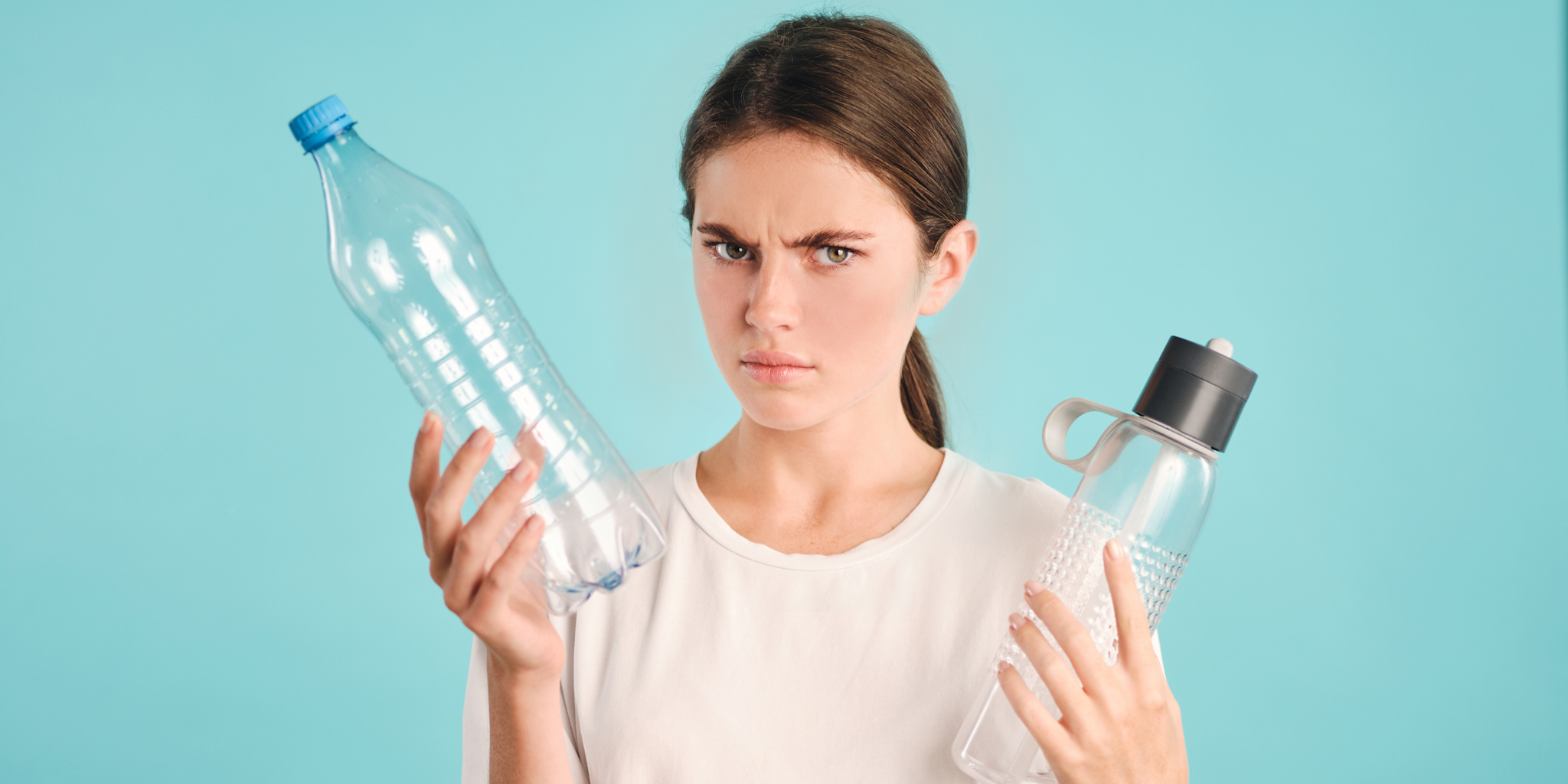Drinking water is essential to sustain life, and an adequate, safe, and accessible supply must be available to all. Water is the most important component of nutrition, and it plays a vital role in all biochemical reactions, from the digestion, absorption, and transport of nutrients to energy production in the human body9. Given the availability of tap water and bottled water choices, along with numerous health organisations like the NHS advising people to consume a minimum 6 to 8 cups or glasses of fluids daily. If you're eager to learn more about the ideal water intake and the ongoing confusion surrounding it, check out our blog titled 'How much water should you drink a day?' We delve into the public's uncertainty about the appropriate amount of plain water to consume.
Now, it's time for you to delve into the potential health hazards associated with plastic water bottles.
So, why is drinking from plastic bottles bad?
The bottled water industry is mostly proclaimed as having negative human and environmental influences, plastic water bottles bad for your health, and an excess of energy and resources are used in the process of bottles manufacturing1. For a long time, bottled water was only available in glass containers; but nowadays polyethylene terephthalate is widely used for packaging. Polyethylene terephthalate is a type of plastic which is smooth, transparent, and relatively thin. Sadly, polyethylene terephthalate is manufactured for single use only2, therefore reusing plastic bottles is bad for your health. As disposable bottles are used repeatedly, an increased amount of chemicals and toxins seep out from the plastic into the water. This process can lead to the accumulation of harmful substances such as di (2- ethylhexyl) phthalate (DEHP) in your bloodstream, potentially resulting in severe health issues. Additionally, scratches and chips on the soft plastic can create favourable conditions for bacteria to thrive, and the shape of numerous bottle designs poses challenges for effective cleaning.
Why are plastic bottles bad for your health?
Health scares relating to plastic that have gained significant public attention in news media. These focus on the increasing toxic load on bodies because of chemicals leaching from plastic3. Improper storage of bottled water harms consumers, because elevated temperatures are responsible for the release of antimony from polyethylene terephthalate plastics used for water bottles6. Antimony is a regulated contaminant that can cause nausea, vomiting, diarrhoea, and even chronic health effects in drinking water7. The researchers also found that the longer the water is stored in plastic bottles, the higher concentration of antimony is leached8. Research by Mason, Welch, and Neratko (2018) examined twenty-seven different lots of bottled water from 11 different brands purchased in 19 locations across nine different countries, they were analysed for microplastic contamination using a Nile Red stain, which adsorbs to polymeric material and fluoresces under specific wavelengths of incident light. Nile Red adsorbs to hydrophobic (“water-fearing”) materials, which are not reasonably expected to be naturally found within bottled water. Of the 259 total bottles analysed, 93% showed signs of microplastics4. Data suggests the contamination is at least partially coming from the packaging and/or the bottling process itself5.
Choose Doulton Water Filters for Purer Hydration and Eco-Friendly Living?
Discover the exceptional alternatives to plastic water bottles with Doulton Water Filters. Whether you opt for the filtered water gravity system or the convenient undercounter filter with pillar tap, both options are highly effective in purifying tap water by removing impurities. Utilising activated carbon and advanced filtering media, these filters excel at eliminating contaminants such as chlorine, lead, heavy metals, and particles as smaller than microplastic. For a more details on Microplastics, why don’t you have a read of ‘Microplastics in Water’ blog, in this blog we shed light on the detrimental effects of microplastics
The National Library of Medicine indicates that Microplastics can vary in size from 1 to 1000 microns. With Doulton Water Filters boasting a filtration rating of 0.5 to 0.9 microns for their filter elements, they excel at capturing particles of even microscopic sizes. For example, in the case of Microplastics at 1 micron, all Doulton filters can efficiently trap particles as small as 0.9 microns.
Opting for filtered tap water isn't just beneficial for your health—it's also a win for the environment. Say goodbye to the risks associated with plastic bottles and ensure that every sip you take is safe and clean. Purifying your own tap water is the ultimate way to achieve peace of mind and a reliable source of refreshing hydration. With Doulton Water Filters, you can enjoy pure, great-tasting water while minimising plastic waste. Embrace quality and sustainability by making the smart choice for both your health and the planet.
References:
1. Garfí, M., Cadena, E., Sanchez-Ramos, D., & Ferrer, I. (2016). Life cycle assessment of drinking water: comparing conventional water treatment, reverse osmosis and mineral water in glass and plastic bottles. Journal of cleaner production, 137, 997-1003.
2. Alabi, O. A., Ologbonjaye, K. I., Awosolu, O., & Alalade, O. E. (2019). Public and environmental health effects of plastic wastes disposal: a review. J Toxicol Risk Assess, 5(021), 1-13.
3. Hawkins, Gay (2011). Packaging water: plastic bottles as market and public devices. Economy and Society, 40(4), 534–552. doi:10.1080/03085147.2011.602295
4. Mason, S. A., Welch, V. G., & Neratko, J. (2018). Synthetic polymer contamination in bottled water. Frontiers in chemistry, 407.
5. Mason, S. A., Welch, V. G., & Neratko, J. (2018). Synthetic polymer contamination in bottled water. Frontiers in chemistry, 407.
6. Akhbarizadeh, R., Dobaradaran, S., Schmidt, T. C., Nabipour, I., & Spitz, J. (2020). Worldwide bottled water occurrence of emerging contaminants: a review of the recent scientific literature. Journal of hazardous materials, 392, 122271.
7. Akhbarizadeh, R., Dobaradaran, S., Schmidt, T. C., Nabipour, I., & Spitz, J. (2020). Worldwide bottled water occurrence of emerging contaminants: a review of the recent scientific literature. Journal of hazardous materials, 392, 122271.
8. Akhbarizadeh, R., Dobaradaran, S., Schmidt, T. C., Nabipour, I., & Spitz, J. (2020). Worldwide bottled water occurrence of emerging contaminants: a review of the recent scientific literature. Journal of hazardous materials, 392, 122271.
9. Altın, B., & Aksoy, S. (2022). Is Inadequate Water Intake a Risk Factor for Vestibular Disorders?. J Int Adv Otol, 18(3), 264-268.






